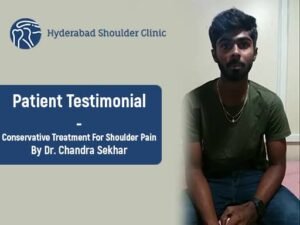All over the world, millions of people experience shoulder pain and seek help from a doctor. For most of them, rest and physical therapy should heal their pain. But in the cases of a torn rotator cuff, treatment from an orthopaedic surgeon is required.
The rotator cuff is a combination of four muscles that form tendons around the shoulder joint. If one or more of these tendons are torn fully or partially, it is called a rotator cuff injury. A repetitive motion common among professional athletes causes the tear. Ageing-related wear and tear and overuse are the more common cause of rotator cuff injuries. Shoulder arthroscopy is performed to repair these tears.
Immediate pain: The patient experiences a quick, sharp pain in the shoulder. Due to heavy lifting and falls, patients suffer an acute tear, i.e. a single injury causes an acute rotator cuff tear.
Dull pain: Tears caused by repetitive motion cannot be isolated to one incident. Here, the patient notices a continuous, dull ache in their shoulder.
The patient experiences pain while lying down on the affected shoulder. They feel the affected arm is weak and limits their ability to move it in different positions. Simple tasks that involve lifting and rotating the affected arm cannot be performed.
When is Shoulder Arthroscopy recommended?
Shoulder arthroscopy is a technique to treat a variety of shoulder joint injuries, and it differs from traditional, open approaches to surgery. The doctors start with a physical examination and some diagnostics. Based on the severity of the injury, your doctor might prescribe more conservative treatments first. Rest and ice can help manage your symptoms, along with physical therapy to strengthen the injured tendons.
If the patient has a severe tear, experiencing constant pain, and is not responding to more conservative treatment, surgery might be suggested.
Shoulder Arthroscopy Procedure

In arthroscopic surgery, the surgeon will make several half-inch incisions to reach the injured tendon instead of making a large incision. A thin camera, known as an arthroscope, is inserted into one of the incisions to see the affected area. Through the other incisions, specialized surgical tools that assist the surgeon in removing scar tissue and bone spurs are inserted. Plastic screws and sutures repair the torn tendon.
How long does it take to recover from arthroscopic shoulder rotator cuff repair?
Recovery is a stage-wise process. Immobilization in a sling for four to six weeks after the surgery is mandatory. One can return to some of your normal activities within a few days of surgery. Try walking but do not swing the affected arm.
Physical Therapy is necessary to regain motion and strengthen the area. Generally speaking, full recovery typically takes four to six months. Heavy lifting takes longer. Any change in your physical activities that will put significant strain on your shoulder must be first discussed with your doctor and physical therapist.
Post Operative Recovery depends on the following factors:
Pain Management

After the surgery, you will be shifted to the postoperative recovery area, and after the anaesthesia wears off, you may feel groggy or nauseous. For most patients, this is an outpatient procedure, so the anaesthesia will wear off naturally, and you can go home the same day as your procedure.
After the anaesthesia wears off, and you go home, pain management is key. You can do the below things to stay comfortable after surgery:
Apply Ice: Ice will help alleviate some pain and reduce swelling. An ice pack must be placed intermittently on the shoulder, but be sure you do not get the incision area wet. Hence, wrap the ice in a thin towel around the ice and apply it for approximately 20 minutes at a time.
Pain Medications: The main medications will be antibiotics and pain relievers. Please check with your doctor before taking any pain medication, as some of them impact bleeding.
Sleeping posture: Immediately after the surgery, sleeping will be challenging, and it might last up to six weeks. If possible, sleep on a reclining chair or prop yourself up on a bed using pillows. For those used to sleeping on the side, you can sleep on your other shoulder. However, you may sleep and keep the affected arm up and away from your body.
Physical therapy

The three main stages of Physical Therapy are:
- In the physical therapy session, you will start with passive motion to the shoulder to avoid the excessive strain of muscles and tendons.
- Slowly you will progress to active motion, which means you have to move your arm.
- Then finally, you will do resistance exercises to strengthen the shoulders.
The entire physical therapy phase lasts for a few months after the surgery. You should also do daily at-home exercises to do. A shoulder pulley system will be able to aid in keeping up with your shoulder therapy exercises at home.
After recovering fully, please put the injury out of your mind and move forward with your life. We at Hyderabad Shoulder Clinic would want you to be able to get back to the activities you love, and please take precautions to prevent re-injury of the rotator cuff. We at Hyderabad Shoulder Clinic will give you full guidance to recover fully from Arthroscopic Shoulder Rotator Cuff Repair. Please visit our website https://hyderabadshoulderclinic.com/ or contact us at
+91 9959588389, shoulderandsportsclinic@gmail.com.





